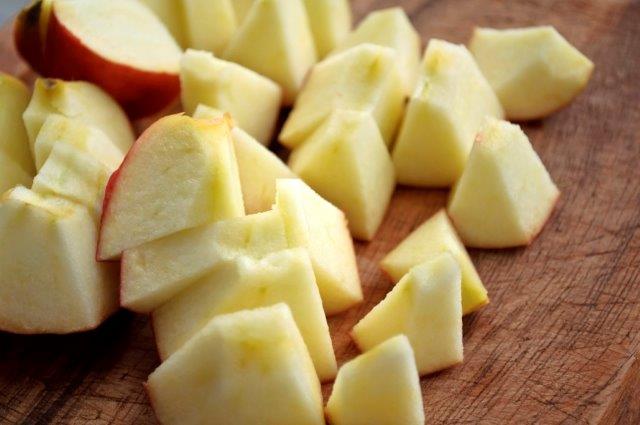EMBARGOED FOR RELEASE | September 10, 2013
Edible coatings for ready-to-eat fresh fruits and vegetables
Note to journalists: Please report that this research was presented at a meeting of the American Chemical Society.
A press conference on this topic will be held Tuesday, Sept. 10, at 11:30 a.m. in the ACS Press Center, Room 211, in the Indiana Convention Center. Reporters can attend in person or access live audio and video of the event and ask questions at www.ustream.tv/channel/acslive.
INDIANAPOLIS, Sept. 10, 2013 — The scientist who turned fresh-cut apple slices into a popular convenience food, available ready-to-eat in grocery stores, school cafeterias and fast-food restaurants, today described advances in keeping other foods fresh, flavorful and safe for longer periods of time through the use of invisible, colorless, odorless, tasteless coatings.
The overview of these edible films was part of the 246th National Meeting & Exposition of the American Chemical Society (ACS), the world’s largest scientific society. The meeting, which continues through Thursday in the Indiana Convention Center and downtown hotels, features almost 7,000 presentations on advances in science and other topics.
Attila E. Pavlath, Ph.D., pointed out that the use of edible films has grown dramatically since the mid-1980s, when only 10 companies were in the business, to more than 1,000 companies with annual sales exceeding $100 million today. Ready-to-eat fruits and vegetables now account for about 10 percent of all produce sales, with sales exceeding $10 billion annually. The use of edible films likely will expand dramatically in the future — especially for fruits and vegetables — as health-conscious consumers look for more foods that require minimal preparation like cut fruit and premixed salads, he noted.
“Fruits and vegetables have skins that provide natural protection against drying out, discoloration and other forms of spoilage,” Pavlath explained. He is with the U.S. Department of Agriculture’s Western Regional Research Center in Albany, Calif. “Cutting and peeling remove that natural protection, allowing deterioration and spoilage to begin. It’s visible within minutes for foods like apples and bananas, but occurs without any outward sign for other fruits and vegetables. Nature is a very good chemist and we are learning from that and sometimes improving on it with new edible coatings that protect the quality and nutritional value of food.”
Those coatings consist of a thin layer of edible material applied to the surface of a food product to preserve freshness. Apples, for instance, lose some of their natural wax coating during washing after harvest. The replacement is a thin layer of carnauba wax, obtained from the leaves of palm trees. That wax also gives sugar-coated chocolate candy an appealing gloss. Other common edible coatings include starch, alginate, carrageenan, gluten, whey and beeswax.
Pavlath and his group invented the technology that enabled schoolchildren and other consumers to enjoy a new apple treat — refrigerated, packaged apple slices that last 2-3 weeks without turning brown or losing crispness. Apples ordinarily begin to turn brown within 30 minutes after cutting or peeling. Pavlath’s process involves treating freshly cut apple slices with a form of vitamin C, resulting in the first commercial product that retains the desirable characteristics of fresh apples without leaving a detectable residue.
The ACS Kansas City Section honored Pavlath at the meeting with its Kenneth A. Spencer Award for Outstanding Achievement in Food and Agricultural Chemistry.
Pavlath pointed out that edible films are by no means a 21st century innovation. Edible films were used at least as early as the 1100s, when merchants in citrus-growing regions of southern China used wax to preserve oranges shipped by caravan to the Emperor’s table in the North. People in Europe for centuries preserved fresh fruit with “larding,” a coating of the melted fat from hogs. Those coatings sealed off the fruit, preventing the exchange of gases with the air, essential for sustaining good quality.
Today’s edible films, however, allow that exchange of gases and have other features that maintain freshness, flavor, aroma, texture and nutritional value. They generally provide the same protection against bacteria as the natural skin if the foods are handled under sterile conditions when they are cut in the factory, Pavlath said. Workers either spray on the films or immerse the foods in the liquid coating after cutting. The finished fruits and vegetables then go to consumers in sealed containers.
The great 21st century challenges in edible coating research and development? Pavlath cited two challenges. One involves bananas, America’s favorite fruit, which people consume each year in quantities greater than apples and oranges combined: finding an edible coating that would make fresh-cut sliced bananas a commercial reality. The other is developing a coating for avocados, which are also notorious for discoloring quickly after peeling.
To automatically receive news releases from the American Chemical Society, contact newsroom@acs.org.
# # #
The American Chemical Society is a nonprofit organization chartered by the U.S. Congress. With more than 163,000 members, ACS is the world's largest scientific society and a global leader in providing access to chemistry-related research through its multiple databases, peer-reviewed journals and scientific conferences. Its main offices are in Washington, D.C., and Columbus, Ohio.
Media Contact
During the national meeting, Sept. 6-11, the contacts can be reached at 317-262-5907.
Michael Bernstein
m_bernstein@acs.org
202-872-6042
Michael Woods
m_woods@acs.org
202-872-6293






